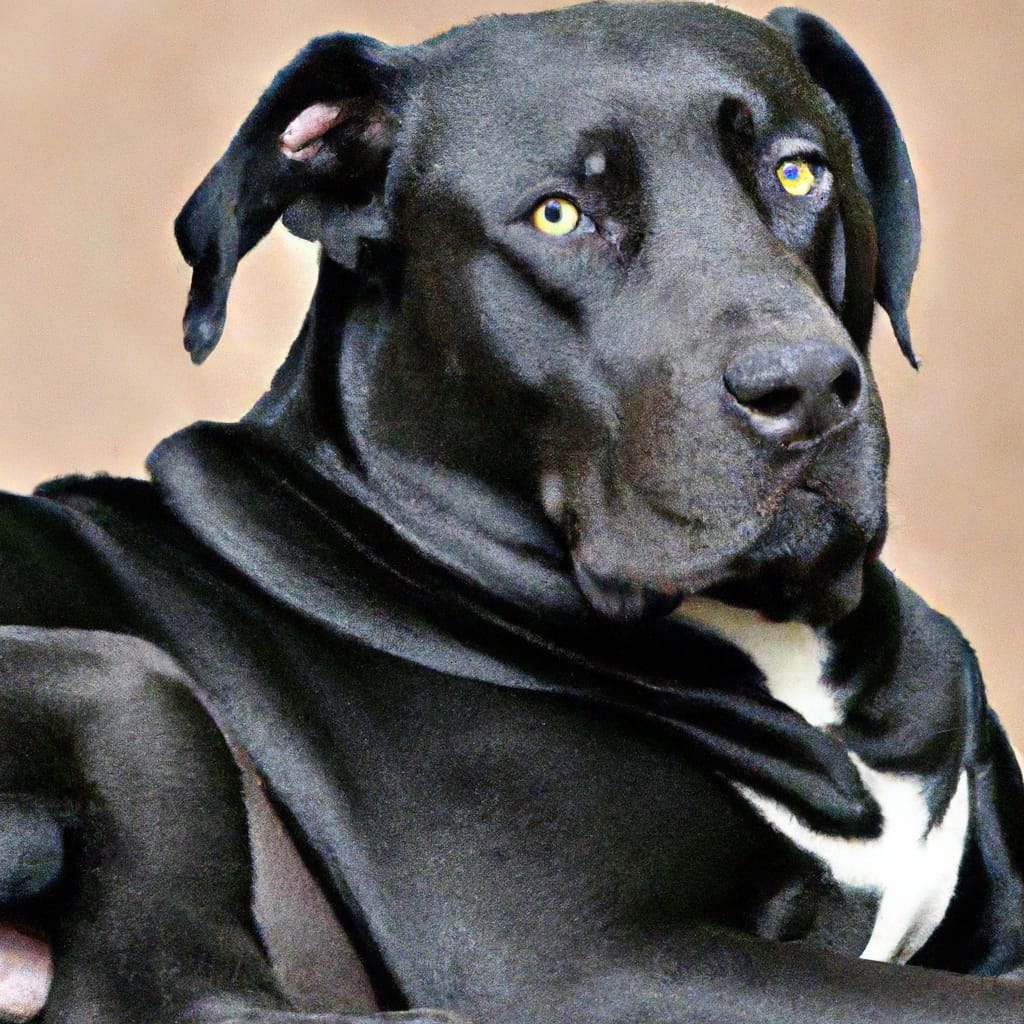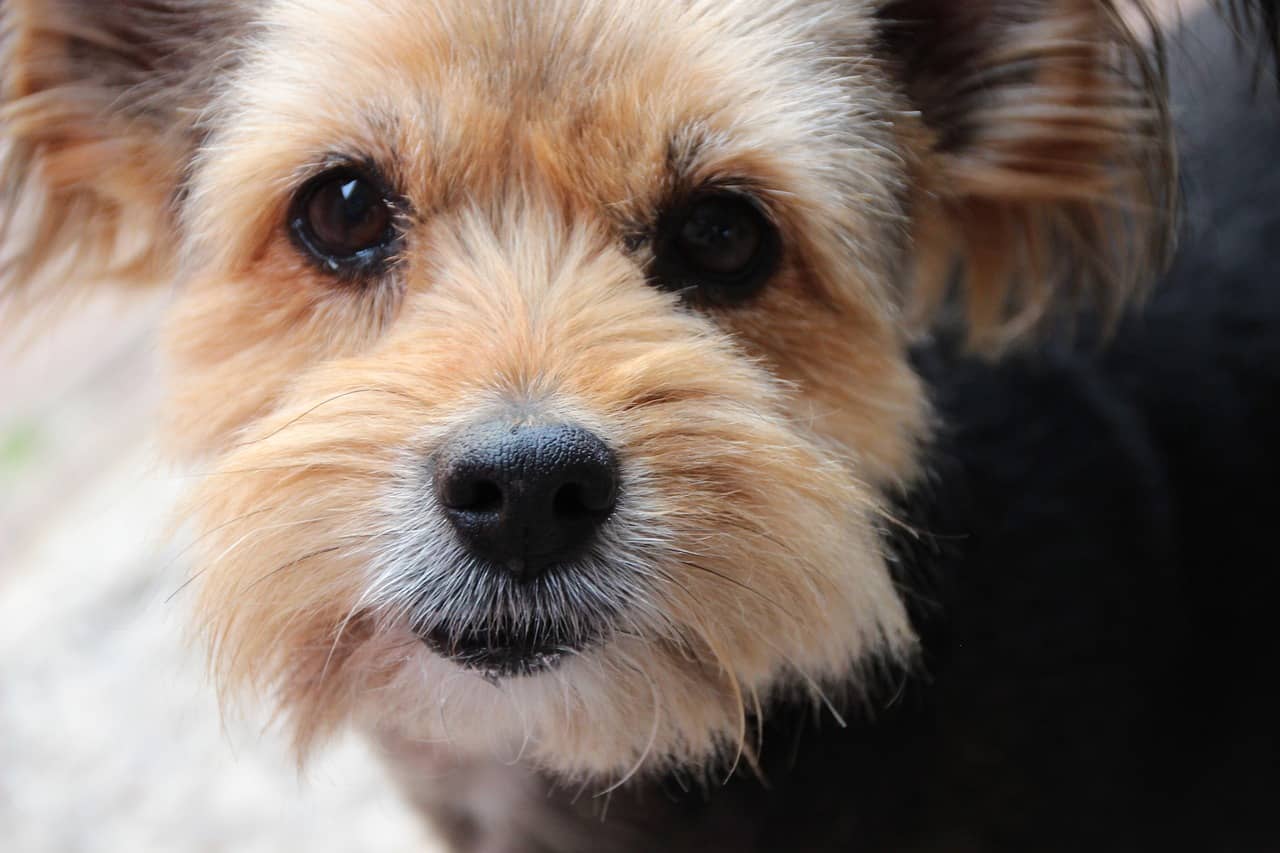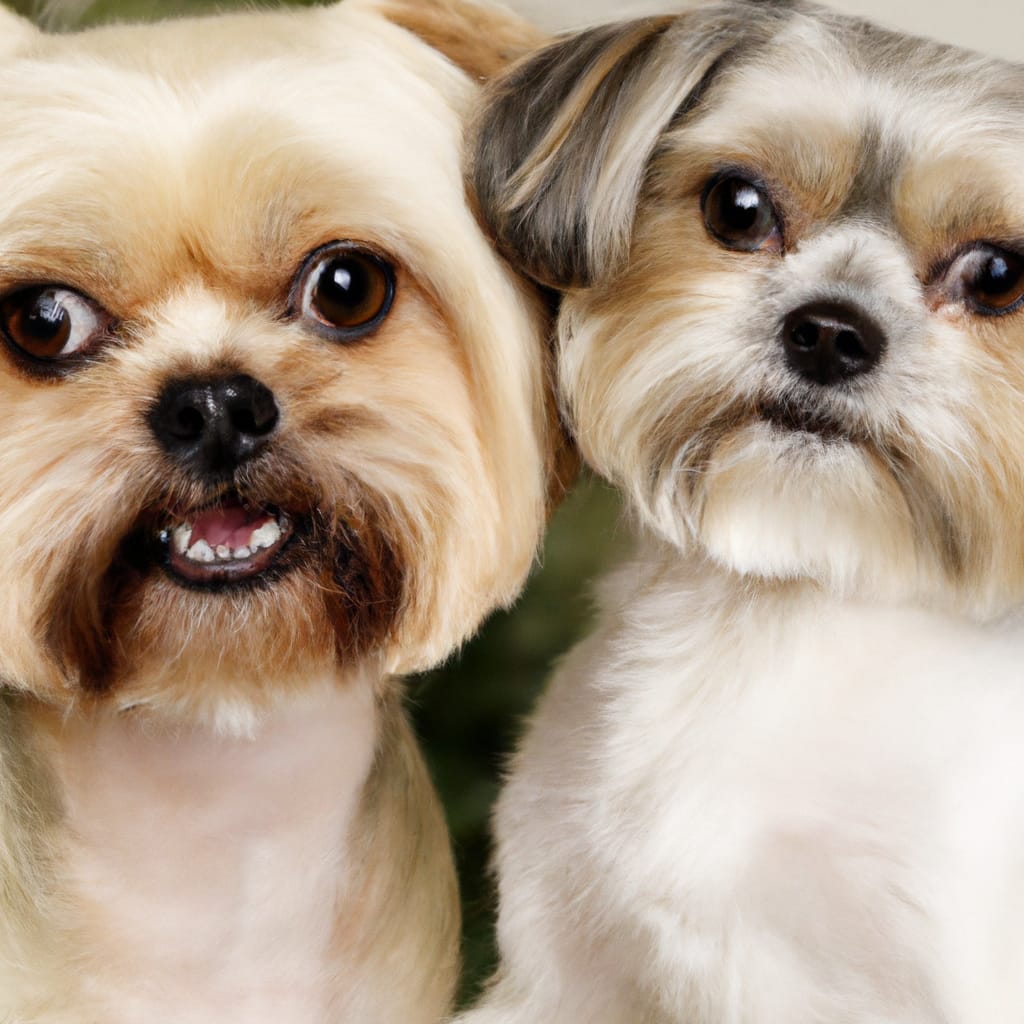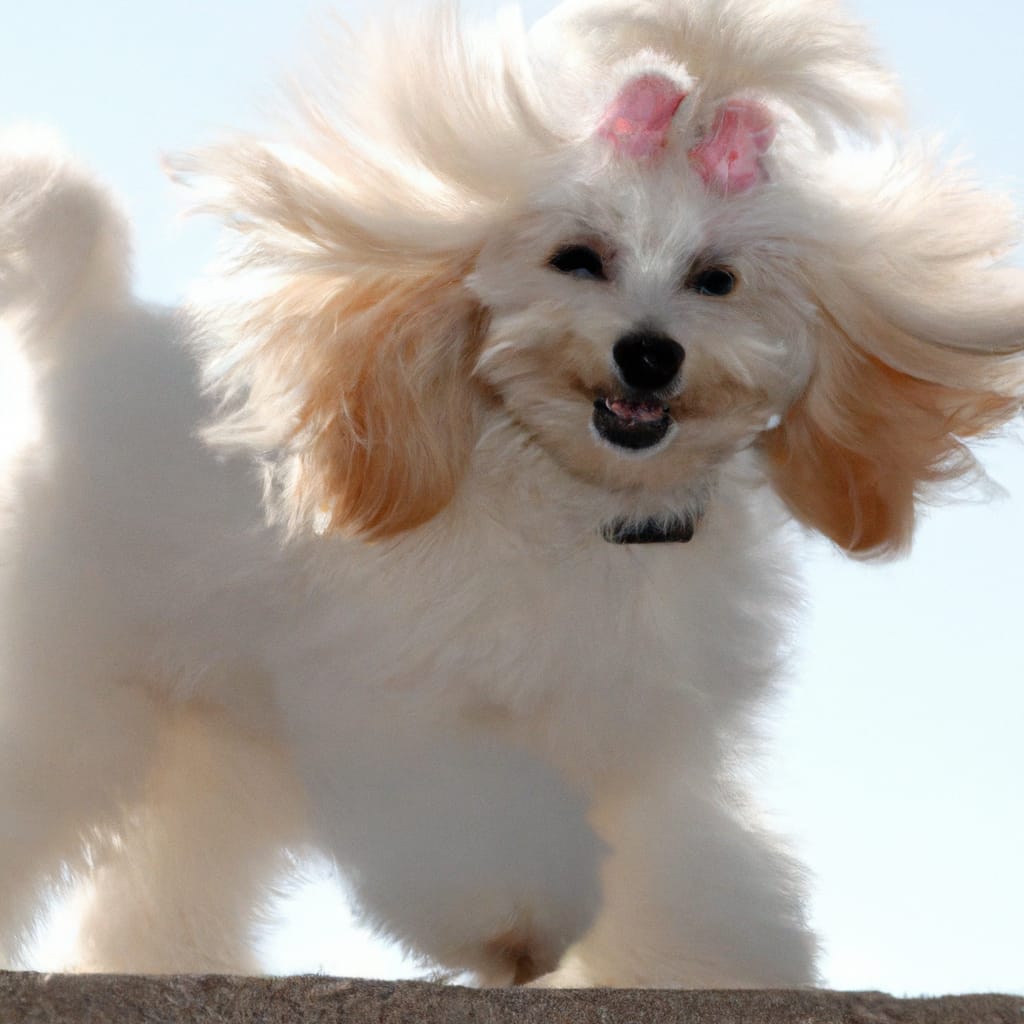Top 10 Tallest Dog Breeds In The World
Are you ready to learn about some of the tallest dog breeds in the world? In this article, we will explore the top 10 breeds that tower above the rest. From the majestic Great Dane to the elegant Irish Wolfhound, these dogs are sure to leave you amazed at their impressive heights. So, let’s embark on this journey and discover the giants of the canine world.
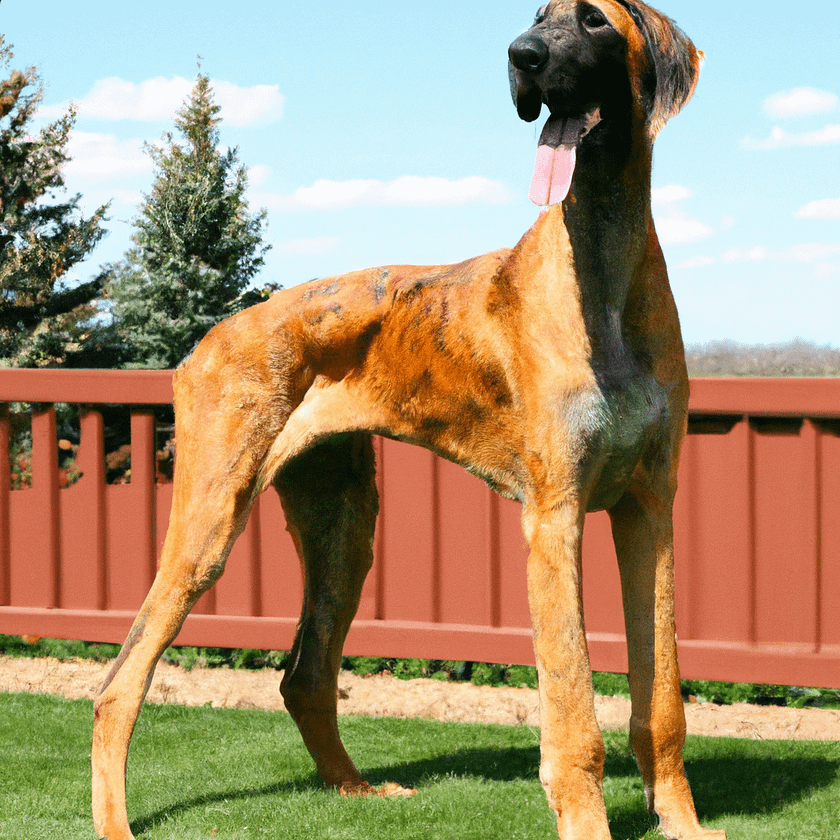
1. Great Dane
Appearance
The Great Dane is a majestic and powerful dog breed with a commanding presence. Its elegant and muscular body is well-proportioned, with a deep chest and a long, lean neck. The breed has a short coat that comes in a variety of colors, including brindle, fawn, black, and harlequin. Their distinctive head is broad and features a strong, square muzzle. With their expressive and gentle eyes, Great Danes have a regal and dignified appearance.
Height and Weight
When it comes to height, Great Danes take the crown as one of the tallest dog breeds in the world. On average, male Great Danes stand at an impressive height of 30 to 34 inches at the shoulder, while females are slightly shorter, ranging from 28 to 32 inches. As for weight, these gentle giants are no slouch either. Male Great Danes typically weigh between 140 to 175 pounds, while females weigh slightly less, averaging between 110 to 140 pounds.
Temperament
Despite their large size, Great Danes are known for their friendly and affectionate nature. They are often referred to as “gentle giants” due to their calm and patient demeanor. Great Danes are generally good-natured and sociable, making them excellent family pets. They are loyal, protective, and great with children, making them a popular choice for families. However, it is important to provide proper socialization and training from a young age to ensure they grow up to be well-behaved and obedient.
Care and Training
Taking care of a Great Dane requires some special considerations due to their size. Regular exercise is essential for this breed to prevent them from becoming overweight and to keep them fit. Daily walks and play sessions in a secure, spacious area are recommended. Great Danes should be provided with a balanced diet that is appropriate for their size and age to maintain their overall health. Grooming needs are relatively low for Great Danes since their short coat only requires occasional brushing to keep it clean and tidy. However, their ears should be regularly checked and cleaned to prevent any infections.
When it comes to training, positive reinforcement methods work best with Great Danes. They are intelligent dogs, but can occasionally exhibit stubbornness. Consistency, patience, and rewarding good behavior are key to effectively train them. Early socialization is crucial to expose them to various people, animals, and situations, ensuring they become well-adjusted adults. Professional obedience classes can also be beneficial in teaching them basic commands and reinforcing good manners.
2. Irish Wolfhound
Appearance
The Irish Wolfhound is a noble and striking dog with a commanding presence. This breed is known for its impressive size and unique appearance. They are large and muscular, with a deep chest and a long, graceful neck. Irish Wolfhounds are characterized by their rough, wiry coat, which comes in various colors like gray, brindle, red, black, and white. They have a long, narrow head with a strong muzzle and small, dark eyes that exude kindness and intelligence.
Height and Weight
Irish Wolfhounds are renowned for their incredible height, making them one of the tallest dog breeds in the world. On average, male Irish Wolfhounds reach heights of 32 to 34 inches at the shoulder, while females measure slightly smaller, ranging from 30 to 32 inches. In terms of weight, male Irish Wolfhounds can weigh anywhere between 140 to 180 pounds, while females average between 115 to 140 pounds. Their size is truly awe-inspiring.
Temperament
Despite their imposing stature, Irish Wolfhounds are known for their gentle and affectionate nature. They are incredibly loyal and form deep bonds with their families. Irish Wolfhounds are often described as being friendly, patient, and gentle giants. They get along well with children and other pets, making them a fantastic addition to a household. However, due to their large size, caution should always be exercised when introducing them to smaller animals or young children to prevent accidental injuries.
Care and Training
Proper care is essential for ensuring the well-being of an Irish Wolfhound. Despite their size, this breed has relatively low exercise requirements. Daily walks and regular opportunities for moderate exercise are sufficient to keep them healthy and happy. However, it is important to avoid vigorous exercise or prolonged activity, especially during their growth period, to prevent potential joint and bone issues.
Irish Wolfhounds have a wiry and dense coat that requires regular grooming to prevent matting and tangling. Brushing their coat at least once a week and occasional hand-stripping will help maintain its condition. Their ears should be checked and cleaned regularly to prevent infections. Irish Wolfhounds have a slightly higher risk of certain health issues, including bloat, heart conditions, and bone cancers, so regular veterinary check-ups are crucial.
Training Irish Wolfhounds should begin early to establish good behavior and ensure they grow up to be well-mannered companions. Positive reinforcement techniques and consistency are key when training this breed. Irish Wolfhounds are generally intelligent and respond well to gentle guidance. Early socialization is also crucial to expose them to different people, animals, and environments, ensuring they become well-adjusted adults.
3. English Mastiff
Appearance
The English Mastiff is a massive and powerful breed that exudes strength and dignity. They have a well-muscled and solid build, with a broad head and a distinctively wrinkled face. The breed has a short coat that comes in various colors such as apricot, fawn, or brindle. English Mastiffs have deep-set, expressive eyes and a strong jawline, which adds to their overall imposing appearance. They have a gentle and calm expression that reflects their kind and gentle nature.
Height and Weight
English Mastiffs are known for their incredible size, making them one of the largest dog breeds in terms of weight. On average, male English Mastiffs stand at a height of 30 inches or more at the shoulder, while females are slightly smaller, ranging from 27.5 inches and up. In terms of weight, these gentle giants can tip the scales at an astounding 160 to 230 pounds for males and 120 to 170 pounds for females.
Temperament
English Mastiffs are renowned for their gentle and affectionate nature, often described as “gentle giants.” Despite their massive size, they are known to be docile, calm, and extremely loyal to their family. English Mastiffs are excellent family pets and are especially good with children due to their patient and protective nature. They are generally friendly towards strangers but make excellent watchdogs due to their protective instincts.
Care and Training
Taking care of an English Mastiff requires some special considerations due to their size and specific health needs. Regular exercise is important to keep them physically and mentally stimulated, but it should be low-impact and not overly strenuous to prevent strain on their joints. Daily walks and short play sessions in a secure area are sufficient to meet their exercise needs. However, it’s crucial to monitor them closely during hot weather as they are susceptible to heatstroke.
Grooming needs for English Mastiffs are relatively low. Their short coat only requires regular brushing to keep it clean and healthy. However, their facial wrinkles should be cleaned regularly to prevent any irritation or infections. English Mastiffs have a higher risk of certain health issues, including hip and elbow dysplasia, bloat, and heart conditions, so regular veterinary check-ups and a balanced diet are essential for their well-being.
Training an English Mastiff should start from an early age to establish boundaries, manners, and obedience. These dogs respond well to positive reinforcement techniques and consistency. Early socialization is important to expose them to various people, animals, and situations to ensure they grow up to be well-adjusted adults. Due to their size and strength, it is crucial to establish firm leadership and provide them with proper guidance and structure.
4. Saint Bernard
Appearance
The Saint Bernard is a giant and muscular dog breed with a kind and gentle expression on its face. They have a powerful and well-balanced body, with a broad head and expressive eyes. The breed boasts a dense and thick coat that comes in a variety of colors, including red and white, mahogany, and brindle. Saint Bernards are known for their noble and dignified appearance, which draws attention wherever they go.
Height and Weight
Saint Bernards are known for their impressive size, both in height and weight. On average, male Saint Bernards reach heights of 27 to 30 inches at the shoulder, while females measure slightly smaller, ranging from 25 to 28 inches. When it comes to weight, these gentle giants can weigh anywhere between 140 to 180 pounds for males and 120 to 140 pounds for females, making them one of the heaviest dog breeds.
Temperament
Saint Bernards are renowned for their gentle and friendly nature. Despite their large size, they are known to be good-natured, patient, and tolerant dogs. They are excellent with children and usually get along well with other pets, which makes them wonderful family pets. Saint Bernards are known to be very loyal and protective of their loved ones, and their calm and steady temperament makes them great therapy dogs or search and rescue dogs.
Care and Training
Caring for a Saint Bernard requires some special considerations due to their size and specific needs. Daily exercise is important to keep them physically and mentally stimulated, but it should be moderate and not overly exerting to prevent joint and mobility issues. Regular walks and gentle play sessions are suitable for this breed. However, it is important to avoid excessive exercise or intense activities during their growth period to prevent any strain on their developing bones and joints.
Grooming needs for Saint Bernards are relatively moderate. Their dense coat should be brushed regularly to prevent matting and to keep it clean and healthy. Their ears should be checked and cleaned regularly to prevent any infections. Saint Bernards have a higher risk of certain health issues, including hip and elbow dysplasia, bloat, and heart conditions. Therefore, regular veterinary check-ups, a balanced diet, and maintaining a healthy weight are crucial.
Training a Saint Bernard should start from a young age to establish good behavior and ensure they grow up to be well-mannered companions. Positive reinforcement methods work best with this breed, as they tend to be sensitive and respond well to gentle guidance. It is important to provide consistent training, socialization, and clear boundaries to help them develop into confident and obedient dogs.
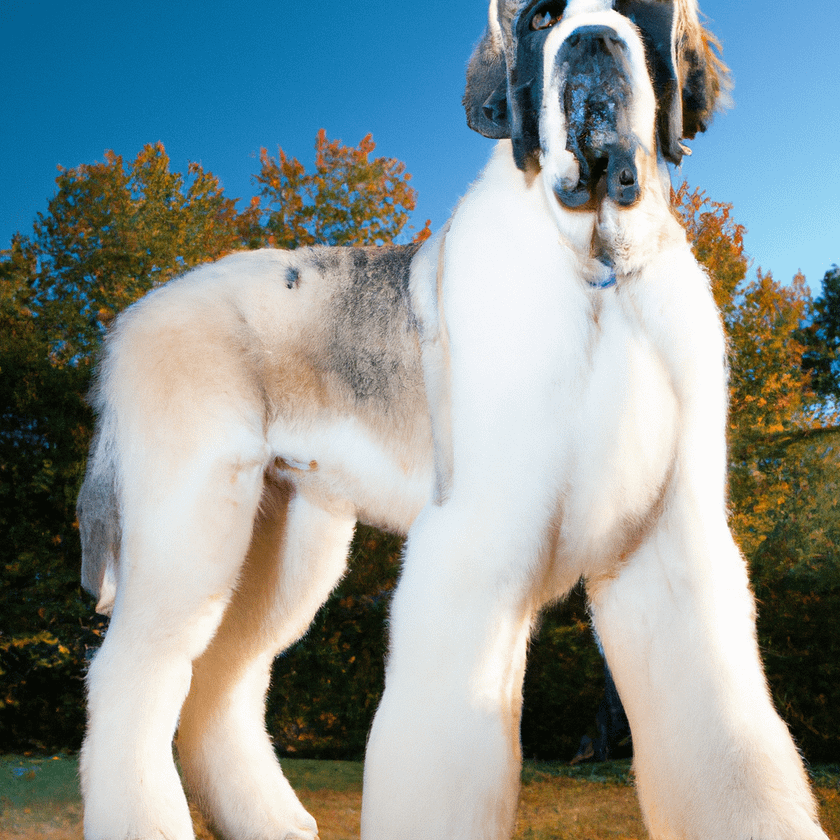
5. Scottish Deerhound
Appearance
The Scottish Deerhound is a majestic and elegant dog breed with a distinctive appearance. They have a tall and lean body, perfect for efficient and agile movement. The breed’s long, wiry coat adds to its unique charm and comes in a variety of colors, such as brindle, gray, or blue-gray. Scottish Deerhounds have a large, broad head with a gentle expression and a keen, intelligent gaze. Their overall appearance is graceful and harmonious, reflecting their noble heritage.
Height and Weight
Scottish Deerhounds are known for their impressive height and slim physique. On average, male Scottish Deerhounds reach heights of 30 to 32 inches at the shoulder, while females measure slightly smaller, ranging from 28 to 30 inches. In terms of weight, male Scottish Deerhounds can weigh between 85 to 110 pounds, while females average between 75 to 95 pounds. Their tall and slender build allows them to excel in agility and speed.
Temperament
Scottish Deerhounds are renowned for their gentle and dignified nature. They are known to be quiet, loyal, and loving companions. Despite their regal appearance, they are generally laid-back and friendly dogs. Scottish Deerhounds are excellent family pets and form deep bonds with their loved ones. They are usually good with children and other pets, making them a suitable addition to a household. However, early socialization is important to introduce them to various people, animals, and situations.
Care and Training
Taking care of a Scottish Deerhound requires some specific considerations due to their thin coat and specific needs. Daily exercise is crucial for this breed to prevent them from becoming bored and to keep them physically fit. They are natural athletes and enjoy running and exploring in a secure area. However, it is important to ensure that their exercise is not overly strenuous, especially during the growth period, to prevent any potential joint and bone issues.
Grooming needs for Scottish Deerhounds are relatively low. Their wiry coat requires regular brushing to prevent matting, but occasional hand-stripping is necessary to maintain its shape. Their ears should be checked regularly to prevent any infections. Scottish Deerhounds have a higher risk of certain health issues, including bloat, heart conditions, and bone cancers. Regular veterinary check-ups, a balanced diet, and monitoring their weight are crucial for their well-being.
Training a Scottish Deerhound requires patience, consistency, and positive reinforcement techniques. They are intelligent dogs but can occasionally exhibit independence and stubbornness. Early socialization is important to expose them to different people, animals, and environments, ensuring they become well-rounded adults. Scottish Deerhounds thrive with gentle guidance, clear boundaries, and mental stimulation to prevent boredom.
6. Great Pyrenees
Appearance
The Great Pyrenees is a majestic and powerful dog breed with a beautiful and fluffy white coat. They have a strong and muscular body that is slightly longer than it is tall, giving them a well-balanced appearance. Great Pyrenees have a large and broad head with a proud expression and gentle, almond-shaped eyes. Their coat is thick, weather-resistant, and comes in a white or cream color. Their overall appearance is striking and exudes confidence.
Height and Weight
Great Pyrenees are known for their impressive size, both in height and weight. On average, male Great Pyrenees stand at a height of 27 to 32 inches at the shoulder, while females measure slightly smaller, ranging from 25 to 29 inches. When it comes to weight, these gentle giants can weigh anywhere between 100 to 160 pounds for males and 85 to 115 pounds for females.
Temperament
Great Pyrenees are renowned for their gentle and protective nature. They are known to be calm, patient, and devoted companions. Great Pyrenees are incredibly loyal to their family and have a strong instinct to guard and protect them. They are excellent watchdogs, always alert and ready to create a barrier between their family and any potential threat. Despite their protective nature, Great Pyrenees are generally good-natured and get along well with children and other pets. However, early socialization is important to expose them to various people, animals, and situations.
Care and Training
Caring for a Great Pyrenees requires some special considerations due to their thick coat and specific needs. Regular exercise is important to keep them mentally and physically stimulated. Daily walks and play sessions in a secure, spacious area are recommended. However, it is important to avoid overexertion or intense exercise, especially during hot weather, as Great Pyrenees are susceptible to heatstroke.
Grooming needs for Great Pyrenees are relatively high. Their dense and thick coat requires regular brushing to remove loose hair and prevent matting. During shedding seasons, more frequent brushing may be necessary to manage the amount of hair. Their ears should be checked regularly to prevent any infections. Great Pyrenees are prone to certain health issues, including hip dysplasia and bloat, so regular veterinary check-ups and a balanced diet are crucial.
Training a Great Pyrenees should start from an early age to establish good behavior and ensure they grow up to be well-behaved companions. Positive reinforcement techniques work best with this breed, as they tend to be sensitive and respond well to gentle guidance. Due to their protective nature and instinct to guard, proper socialization and obedience training are crucial to prevent any potential behavioral issues. Clear boundaries, firm leadership, and consistent training methods will help them become well-rounded dogs.
7. Newfoundland
Appearance
The Newfoundland is a massive and robust dog breed with a gentle and friendly expression. They have a strong and muscular body with a broad chest and a deep, powerful neck. Newfoundland dogs have a double coat that is dense and water-resistant, perfect for their original purpose as water rescue dogs. Their coat can be black, brown, or gray, and their face features expressive eyes and a sweet expression that reflects their kind and gentle nature.
Height and Weight
Newfoundlands are known for their impressive size and strength. On average, male Newfoundlands stand at a height of 28 to 30 inches at the shoulder, while females measure slightly smaller, ranging from 26 to 28 inches. In terms of weight, these gentle giants can weigh between 130 to 150 pounds for males and 100 to 120 pounds for females.
Temperament
Newfoundlands are renowned for their gentle and patient nature. They are known to be sweet, calm, and extremely loyal dogs. Newfoundland dogs are excellent with children and are often referred to as “gentle giants.” They are great family pets and are known to get along well with other animals too. Their instinct to rescue and water work makes them natural and dependable companions in and around water. However, early socialization is important to expose them to various people, animals, and situations.
Care and Training
Taking care of a Newfoundland requires some special considerations due to their size and specific needs. Regular exercise is important to keep them physically active and mentally stimulated. Daily walks and swim sessions, if possible, are excellent ways to provide exercise for Newfoundlands. However, it is important to monitor their activity, especially when they are puppies, to prevent stressing their growing joints.
Grooming needs for Newfoundlands are relatively high. Their dense double coat requires regular brushing to prevent matting and to keep it clean and healthy. Extra attention should be given to their undercoat during shedding seasons. Their ears should be checked regularly to prevent any infections. Newfoundlands have a higher risk of certain health issues, including hip and elbow dysplasia, bloat, and heart conditions. Regular veterinary check-ups and a balanced diet are crucial for their well-being.
Training a Newfoundland should start from a young age to establish good behavior and ensure they grow up to be well-mannered companions. Positive reinforcement methods, consistency, and gentle guidance work best with this breed. Newfoundlands are intelligent dogs and are eager to please. Due to their size and strength, basic obedience training and socialization are important to ensure they can be easily controlled in different situations.
8. Leonberger
Appearance
The Leonberger is a majestic and regal dog breed with a distinctive lion-like appearance. They have a large and impressive body with a strong, muscular build. Leonbergers have a head with a distinct mane of fur that frames their face, giving them a majestic and noble look. Their coat is thick and water-resistant, coming in various colors such as lion-yellow, reddish-brown, or pale yellow. Leonbergers have expressive and intelligent eyes that reflect their friendly and gentle nature.
Height and Weight
Leonbergers are known for their impressive size and strength. On average, male Leonbergers stand at a height of 28 to 31.5 inches at the shoulder, while females measure slightly smaller, ranging from 25.5 to 29.5 inches. In terms of weight, these gentle giants can weigh between 110 to 170 pounds for males and 90 to 140 pounds for females.
Temperament
Leonbergers are renowned for their friendly and gentle nature. They are known to be patient, good-natured, and dependable companions. Leonbergers are excellent family dogs and get along well with children and other pets. They are known to be protective of their loved ones and will stand up against any perceived threats. Their calm and steady temperament, combined with their intelligence, makes them wonderful therapy dogs or search and rescue dogs.
Care and Training
Caring for a Leonberger requires some special considerations due to their size and coat. Regular exercise is important to keep them physically fit and mentally stimulated. Daily walks, play sessions, and activities such as swimming are suitable for this breed. However, it is important to monitor their exercise, especially during hot weather, as they are susceptible to heatstroke.
Grooming needs for Leonbergers are relatively high. Their thick and water-resistant coat requires regular brushing to prevent matting and to keep it clean and healthy. Extra attention should be given to their mane and feathering. Their ears should be checked regularly to prevent any infections. Leonbergers have a higher risk of certain health issues, including hip and elbow dysplasia, bloat, and heart conditions. Regular veterinary check-ups and a balanced diet are crucial for their well-being.
Training a Leonberger should start from a young age to establish good behavior and ensure they grow up to be well-mannered companions. They are intelligent dogs and respond well to positive reinforcement techniques and consistency. Early socialization is important to expose them to different people, animals, and environments, ensuring they become well-rounded adults. Due to their size and protective nature, it is important to establish firm leadership and provide them with proper guidance and structure.
9. Afghan Hound
Appearance
The Afghan Hound is an elegant and dignified dog breed with a distinct appearance. They have a tall and slender body, perfect for agility and speed. Afghan Hounds boast a long and flowing coat that is silky and fine in texture. The breed comes in various colors, including black, white, cream, or a combination of colors. Afghan Hounds have a long and narrow head with dark, almond-shaped eyes that exude mystery and intelligence. Their overall appearance is graceful and aristocratic.
Height and Weight
Afghan Hounds are known for their impressive height and slim build. On average, male Afghan Hounds stand at a height of 27 to 29 inches at the shoulder, while females measure slightly smaller, ranging from 25 to 27 inches. In terms of weight, these elegant hounds can weigh between 50 to 60 pounds for males and 45 to 55 pounds for females, making them one of the lighter large breeds.
Temperament
Afghan Hounds are renowned for their independent and aloof nature. They are generally quiet and reserved dogs, often described as being cat-like in behavior. Afghan Hounds are intelligent but can sometimes exhibit stubbornness. They form deep bonds with their family but may be reserved or aloof with strangers. Afghan Hounds require gentle handling and patient training techniques, as harsh methods can backfire on their sensitive temperament.
Care and Training
Caring for an Afghan Hound requires some specific considerations due to their coat and specific needs. Regular exercise is important to keep them mentally and physically stimulated. Afghan Hounds enjoy short bursts of activity, such as play sessions or free runs in a securely fenced area. Daily walks are necessary to prevent them from becoming bored. However, it is important to ensure their exercise is not overly strenuous, especially during hot weather, as they are sensitive to heat.
Grooming needs for Afghan Hounds are relatively high. Their long and flowing coat requires dedicated care to prevent matting and to maintain its beauty. Regular brushing is necessary to keep the coat clean and free from tangles. Afghan Hounds should be bathed regularly to keep their coat and skin in good condition. Their ears should be checked regularly to prevent any infections.
Training an Afghan Hound requires patience, consistency, and positive reinforcement techniques. Due to their independent nature, Afghan Hounds may need extra motivation and gentle guidance. Early socialization is important to expose them to different people, animals, and environments to ensure they grow up to be well-rounded adults. Afghan Hounds benefit from mental stimulation and activities that tap into their natural instincts, such as lure coursing or scent work.
10. Tibetan Mastiff
Appearance
The Tibetan Mastiff is a majestic and powerful dog breed with a distinctive appearance. They have a large and sturdy body, complete with a thick double coat that protects them from harsh weather conditions. Tibetan Mastiffs have a broad head with a strong muzzle and expressive eyes that exude intelligence and confidence. Their coat comes in various colors, including black, brown, gray, and gold. Tibetan Mastiffs have a regal and lion-like appearance, which commands respect and attention.
Height and Weight
Tibetan Mastiffs are known for their impressive size and strength. On average, male Tibetan Mastiffs stand at a height of 26 to 29 inches at the shoulder, while females measure slightly smaller, ranging from 24 to 27 inches. In terms of weight, these majestic creatures can weigh anywhere between 90 to 150 pounds for males and 70 to 120 pounds for females.
Temperament
Tibetan Mastiffs are renowned for their protective and loyal nature. They are known to be independent, strong-willed, and highly intelligent dogs. Tibetan Mastiffs form deep bonds with their families and are extremely devoted. They have a natural instinct to guard and protect, making them excellent watchdogs. Tibetan Mastiffs are usually reserved with strangers, but they are gentle and friendly with their family members.
Care and Training
Caring for a Tibetan Mastiff requires some special considerations due to their size and specific needs. Regular exercise is essential to keep them fit and mentally stimulated. Daily walks and play sessions in a securely fenced area are recommended. However, it is important to avoid overexertion or intense exercise, especially during hot weather, as Tibetan Mastiffs can be heat-sensitive.
Grooming needs for Tibetan Mastiffs are relatively high. Their thick double coat requires regular brushing to prevent matting and to keep it clean and healthy. The undercoat should be checked regularly to ensure it is not becoming matted or tangled. Tibetan Mastiffs are prone to shedding, especially during seasonal changes, so additional brushing during these periods is necessary. Their ears should be checked regularly to prevent any infections.
Training a Tibetan Mastiff should start from an early age to establish good behavior and ensure they grow up to be well-mannered companions. They are intelligent but can be independent and stubborn at times. Positive reinforcement techniques, consistency, and firm leadership are important when training this breed. Early socialization is crucial to expose them to various people, animals, and situations. Tibetan Mastiffs thrive with proper guidance, boundaries, and mental stimulation.








